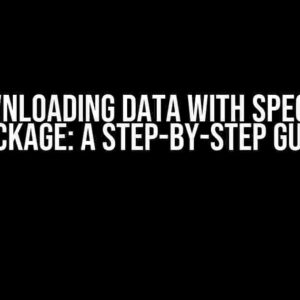Are you tired of tedious image management in your Genesys-powered application? Do you struggle with uploading and downloading images using the Genesys API? Fear not, dear developer! In this in-depth guide, we’ll take you by the hand and walk you through the process of uploading and downloading images using the Genesys API. By the end of this article, you’ll be an image management master, effortlessly uploading and downloading images like a pro!
Before We Begin: Setting Up the Genesys API
Before we dive into the nitty-gritty of uploading and downloading images, make sure you have the following setup:
- A Genesys account with API access
- The Genesys API credentials (username and password or client ID and client secret)
- A programming language of your choice (we’ll use JavaScript and Node.js in our examples)
- A REST client or HTTP library (we’ll use Axios in our examples)
Uploading Images to Genesys using the API
Uploading images to Genesys via the API is a straightforward process. Here’s a step-by-step guide to get you started:
Step 1: Prepare the Image File
Before uploading an image, you need to prepare the file. This involves:
- Reading the image file from your local machine or server
- Converting the image file to a base64-encoded string
const fs = require('fs');
const base64 = require('base64-js');
const imagePath = 'path/to/image.jpg';
const imageBuffer = fs.readFileSync(imagePath);
const imageBase64 = base64.fromByteArray(imageBuffer);
Step 2: Create the API Request
Create a POST request to the Genesys API’s `/v2/media` endpoint, passing the base64-encoded image string in the request body:
const axios = require('axios');
const apiEndpoint = 'https://your-genesys-instance.com/v2/media';
const apiKey = 'your-genesys-api-key';
const apiSecret = 'your-genesys-api-secret';
const headers = {
'Authorization': `Basic ${Buffer.from(`${apiKey}:${apiSecret}`).toString('base64')}`,
'Content-Type': 'application/json'
};
const requestBody = {
'media': {
'type': 'image/jpeg',
'data': imageBase64
}
};
axios.post(apiEndpoint, requestBody, { headers })
.then(response => {
console.log(response.data);
})
.catch(error => {
console.error(error);
});
Step 3: Handle the API Response
The Genesys API will respond with a JSON object containing the uploaded image’s metadata:
{
"id": "image-id-123",
"type": "image/jpeg",
"name": "image.jpg",
"size": 1024,
"uri": "/v2/media/image-id-123"
}
Store the `id` and `uri` properties securely, as you’ll need them to download the image later.
Downloading Images from Genesys using the API
Downloading images from Genesys via the API is just as easy. Here’s how:
Step 1: Construct the API Request
Create a GET request to the Genesys API’s `/v2/media/{imageId}` endpoint, replacing `{imageId}` with the uploaded image’s `id` property:
const axios = require('axios');
const apiEndpoint = `https://your-genesys-instance.com/v2/media/${imageId}`;
const apiKey = 'your-genesys-api-key';
const apiSecret = 'your-genesys-api-secret';
const headers = {
'Authorization': `Basic ${Buffer.from(`${apiKey}:${apiSecret}`).toString('base64')}`
};
axios.get(apiEndpoint, { headers })
.then(response => {
const imageData = response.data;
// Process the downloaded image data
})
.catch(error => {
console.error(error);
});
Step 2: Process the Downloaded Image Data
The Genesys API will respond with the image data as a base64-encoded string. Convert it back to a binary image file:
const base64 = require('base64-js');
const imageData = response.data;
const imageBuffer = base64.toByteArray(imageData);
const imagePath = 'path/to/downloaded/image.jpg';
fs.writeFileSync(imagePath, imageBuffer);
Voilà! You’ve successfully downloaded the image from Genesys using the API.
Troubleshooting Common Issues
Encountered an issue while uploading or downloading images? Check out these common troubleshooting tips:
| Issue | Solution |
|---|---|
| Image upload fails with a 400 error | Verify that the image file is in the correct format (e.g., JPEG, PNG) and that the base64-encoded string is correctly constructed. |
| Image download fails with a 404 error | Ensure that the `imageId` property is correct and that the image exists in Genesys. |
| Image data is corrupted during download | Verify that the base64-encoded string is correctly converted back to a binary image file. |
Best Practices for Handling Images in Genesys
To ensure seamless image management in your Genesys-powered application, follow these best practices:
- Store image metadata securely: Store the `id` and `uri` properties securely, as they’re required for downloading the image.
- Use secure API credentials: Always use secure API credentials (e.g., environment variables, secure storage) to avoid exposing sensitive information.
- Handle errors and exceptions: Implement robust error handling and exception handling to prevent application crashes and data loss.
- Optimize image compression: Optimize image compression to reduce file size and improve upload/download performance.
- Use caching mechanisms: Implement caching mechanisms to reduce the load on the Genesys API and improve application performance.
Conclusion
Mastering the Genesys API for image uploading and downloading is a crucial step in building a robust and scalable application. By following this comprehensive guide, you’ll be well-equipped to handle image management tasks with ease. Remember to stay vigilant and adapt to any changes in the Genesys API, ensuring your application remains agile and efficient.
Now, go forth and conquer the world of image management in Genesys!
Frequently Asked Question
Get ready to unlock the power of Genesys API! If you’re wondering how to upload and download images, we’ve got you covered. Below, we’ll dive into the most frequently asked questions about Genesys API image management.
How do I upload an image to Genesys API?
To upload an image to Genesys API, you’ll need to send a POST request to the /attachments endpoint, with the image file attached as a multipart/form-data payload. Don’t forget to specify the Content-Type header as multipart/form-data and include the file details in the request body. You can also use the Genesys API SDKs to simplify the process.
What is the maximum file size for image uploads in Genesys API?
Genesys API has a maximum file size limit of 10MB for image uploads. If your image file exceeds this limit, you’ll need to compress it or split it into smaller chunks before uploading. Be sure to check the Genesys API documentation for any updates to this limit.
How do I download an image from Genesys API?
To download an image from Genesys API, you’ll need to send a GET request to the /attachments/{attachmentId} endpoint, replacing {attachmentId} with the ID of the image attachment you want to download. The response will contain the image file, which you can then save to your local storage.
Can I upload images in bulk using Genesys API?
Yes, Genesys API supports bulk image uploads using the /attachments/bulk endpoint. You can upload multiple image files in a single request, which can significantly reduce the number of API calls and improve performance. Just be sure to follow the API documentation for the correct request format and payload structure.
How do I handle image upload errors in Genesys API?
When uploading images to Genesys API, it’s essential to handle errors gracefully. Be sure to check the API response for error codes and messages, and implement retry logic to handle temporary failures. You can also use the Genesys API SDKs to simplify error handling and retries.











